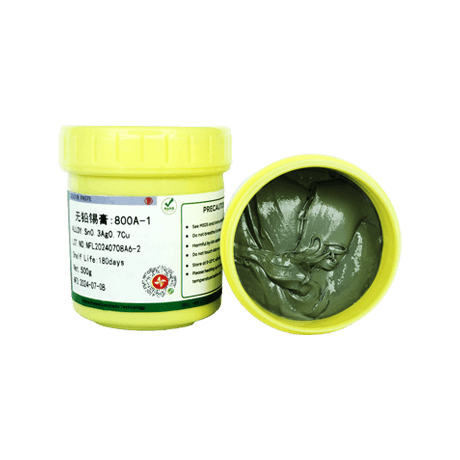Views: 1 创始人: Site Editor Publish Time: 2024-09-28 Origin: Site








无卤素(Halogen-Free),缩写为 HF,是具有环保意识的国家禁止使用某些卤素化合物的要求。它规定材料中卤素(Cl、Br)的平均含量应低于 900 ppm,总含量低于 1500 ppm。因此,无卤素锡膏是指一种符合环保和无铅、无卤素标准的锡膏,而传统锡膏则不符合这些无卤素标准。
除了这一根本区别外,无卤素焊膏还与标准焊膏有其他一些区别: 1. 松香成分差异:无卤助焊膏采用特定的松香合成树脂,其软化点达到135℃,酸值范围在200-300之间。这种松香具有耐高温特性,能在200-400℃的温度范围内稳定使用。高温焊接后,松香残留物保持透明且无色,不会出现发黄现象。由于其高软化点特性,焊接冷却后的松香残留物不会产生潮湿感,手感干爽,不易粘附。
相比之下,普通助焊膏中使用的松香成膜剂为常规松香,软化点约为75℃,酸值大约在100左右。这种松香颜色较深,高温焊接后残留物易发黄。由于松香软化点较低,焊接冷却后的残留物往往带有潮湿感,手感粘滑。
2. 活性剂类型差异:无卤型助焊膏采用非离子型高分子活性剂,具有防潮特性。这种活性剂在常温下稳定,不会引发化学反应,对焊接成品无腐蚀作用。然而,当焊接温度达到100-400℃时,活性剂将迅速释放有效成分,增强对产品的润湿性。焊接完成后,由于活性剂不吸潮,不会对焊接成品造成腐蚀、发霉或漏电等不良影响。
相比之下,普通助焊膏使用离子型活性剂,通常是盐类表面活性剂。此类活性剂焊接性能良好,但易吸潮。在常温下,它们就可能开始与焊接成品发生反应,导致腐蚀。焊接后,残留的活性剂吸潮,可能引发成品漏电、腐蚀或发霉等问题。 3. 触变剂差异显著:无卤型助焊膏采用的触变剂加工出的产品,表面光泽度佳,质地细腻,宛如化妆品一般。在使用过程中,点涂量易于控制,均匀一致。焊接完成后,残留物分布均匀,确保了产品焊接外观的统一与美观。而常规助焊膏通常以石蜡作为触变剂,这种触变剂使得助焊膏质地较为粗糙,容易变硬。在使用时,点涂量不易均匀,容易导致焊接残留物分布不均,进而影响产品外观的一致性。
4. 溶剂差异:无卤助焊膏采用的是进口醚类和醇类溶剂的混合配方,该混合溶剂的沸点较高,挥发速率较慢,故在焊接过程中产生的烟雾和气味较少,对环境的友好性更高。相比之下,传统助焊膏中使用的溶剂多为低沸点的醚类,这类溶剂挥发性强,且醚类物质通常含有毒性,因此在焊接过程中会伴随较多的烟雾和较重的气味。
诺菲尔焊锡膏制造商供应多种产品,包括无铅锡膏、环保型高温锡膏、中温锡膏、低温锡膏、含铅锡膏以及无卤锡膏。此外,我们还生产专用助焊膏、焊锡丝、无铅焊锡丝、松香焊锡丝和无铅焊锡条。选用双智利焊锡厂家的产品,您将享受到全面的技术支持与服务。如需深入了解焊锡知识或解答疑问,欢迎访问双智利焊锡厂家官网,在线留言与我们互动交流。

Halogen-Free, abbreviated HF, is a
requirement in environmentally conscious countries to ban the use of certain
halogen compounds. It specifies that materials should contain an average of
less than 900 ppm of halogens (Cl, Br) and a total of less than 1,500 ppm.
Halogen-Free Solder Paste therefore refers to a solder paste that meets the
environmental and lead-free, halogen-free standards, whereas conventional
solder pastes do not comply with these halogen-free standards.
In addition to this fundamental difference,
halogen-free solder pastes also differ from standard solder pastes in a number
of other ways:
1. Differences in rosin composition:
Halogen-free flux pastes are made from a specific rosin synthetic resin with a
softening point of 135°C and an acid value range of
200-300. This rosin has high temperature resistance properties, can be used in
the temperature range of 200-400 ℃ stable. After
high-temperature welding, the rosin residue remains transparent and colorless
without yellowing. Due to its high softening point characteristics, the rosin
residue after the cooling of the solder will not produce a sense of moisture,
feel dry, not easy to adhere. In contrast, the rosin film-forming agent used in
ordinary flux paste is conventional rosin, with a softening point of about 75 ℃ and an acid value of about 100. This rosin is darker in color, and
the residue is easy to yellow after high-temperature soldering. Due to the
rosin softening point is low, welding residue after cooling is often with a wet
feeling, feel sticky and slippery.
2. Difference in the type of active agent:
non-halogen type flux paste using non-ionic polymer active agent, with
moisture-proof properties. This active agent is stable at room temperature,
will not trigger a chemical reaction, no corrosive effect on the finished
product of welding. However, when the soldering temperature reaches 100-400 ℃, the active agent will quickly release the active ingredients to
enhance the wettability of the product. After the welding is completed, because
the active agent does not absorb moisture, it will not cause corrosion, mold or
leakage and other adverse effects on the finished product. In contrast,
ordinary flux paste using ionic active agent, usually salt surfactants. These
active agents have good soldering properties, but tend to absorb moisture. At
room temperature, they can begin to react with the finished solder, leading to
corrosion. After welding, the residual active agent absorbs moisture and may
trigger problems such as leakage, corrosion or mold in the finished product.
3. Thixotropic agent difference is
significant: halogen-free flux paste using thixotropic agent processing out of
the product, the surface gloss is good, fine texture, like cosmetics. In the
process of use, the amount of spot coating is easy to control, uniform. After
the welding is completed, the residue is evenly distributed to ensure the
uniformity and beauty of the product welding appearance. Conventional flux
paste usually uses paraffin as a thixotropic agent, which makes the texture of
the flux paste more rough and easy to harden. When used, the amount of coating
is not easy to be uniform, which may lead to uneven distribution of soldering
residues, thus affecting the consistency of product appearance.
4. Solvent differences: halogen-free flux
paste is imported ether and alcohol solvent mixture formula, the mixed solvent
boiling point is higher, the evaporation rate is slower, so the welding process
produces less smoke and odor, the friendliness of the environment is higher. In
contrast, the solvents used in traditional flux pastes are mostly low boiling
point ethers, which are highly volatile and etheric substances usually contain
toxicity, so there will be more smoke and heavier odor during the soldering
process.
Nofil solder paste manufacturers supply a
wide range of products including lead-free solder pastes, environmentally
friendly high temperature solder pastes, medium temperature solder pastes, low
temperature solder pastes, leaded solder pastes, and halogen-free solder
pastes. In addition, we manufacture specialty flux pastes, solder wire,
lead-free solder wire, rosin solder wire, and lead-free solder bars. When you
choose Dual-Chile Solder, you'll enjoy comprehensive technical support and
service. For in-depth knowledge of soldering or to answer your questions,
please visit the official website of Dual Chilean Solder Manufacturer and leave
your message online to interact with us.
 苏公网安备32058302004438
苏公网安备32058302004438